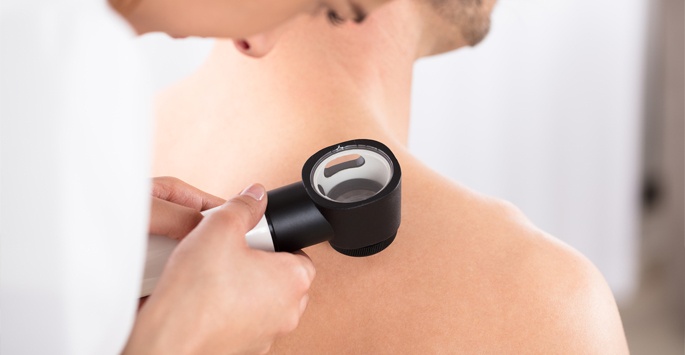Skin Cancer Screening in West Palm Beach, FL
 Suspicious growths may need to be screened further to rule out skin cancer. Skin cancer screenings can effectively be done at Supriya Aesthetic Dermatology for those who live in Jupiter, West Palm Beach, and Palm Beach County.
Suspicious growths may need to be screened further to rule out skin cancer. Skin cancer screenings can effectively be done at Supriya Aesthetic Dermatology for those who live in Jupiter, West Palm Beach, and Palm Beach County.
Early detection increases the cure rate for skin cancer. It’s recommended you do a self-skin exam every month.
The ABCDE rule is a guide to the usual signs of skin cancer. Tell your doctor about any spots that match the following description:
A is for ASYMMETRY: One half of a mole or birthmark does not match the other.
B is for BORDER: Normal spots have smooth edges. Cancerous spots may have irregular, ragged, notched, or blurred edges.
C is for COLOR: The color is not the same all over and may include shades of brown or black or sometimes with patches of red, white, or blue.
D is for DIAMETER: Normal spots are about the size of a pencil end-about 1/4 inch- anything larger is worrisome.
E is for EVOLUTION: If there is any change to the spot or growth.
Any change in size, shape or color of a mole or the appearance of a new spot should be check by a doctor. Some melanomas, the deadliest form of skin cancer, do not fit the ABCDE rule described above, so it is very important for you to notice changes in skin markings or new spots on your skin.
Other warning signs are:
- a sore that does not heal
- a new growth
- spread of pigment from the border of a spot to surrounding skin
- redness or a new swelling beyond the border
- change in sensation — itchiness, tenderness, or pain
- change in the surface of a mole — scaliness, oozing, bleeding, or the appearance of a bump or nodule
Another way to check for skin cancer is by taking a biopsy of tissues and having them examined at a laboratory. A biopsy can be done on an outpatient basis, and patients are able to return to normal activities shortly afterwards.
How is a biopsy performed?
That can depend on the location and size of the lesion that’s being removed. A physician may perform one of four different types of biopsies including the following:
- Shave biopsy: lesion is shaved or scraped off by using a very thin blade
- Punch biopsy: uses a special instrument to “punch” through the skin and lift out a circular area of growth and surrounding tissue.
- Incisional biopsy: part of the growth is removed with a scalpel
- Excisional biopsy: all of the growth is removed using a scalpel
Before taking a biopsy, a local anesthetic is administered. This allows the patient to be fully awake while not feeling any pain. Once the required tissues have been removed, the wound will be allowed to heal or sutured and then a bandage is placed.
How long does it take to receive results after a skin biopsy?
That depends upon the location and workload of the lab where tissues are sent. In most cases, results are obtained within one week after the procedure.
What happens if a biopsy screening reveals cancer?
Surgery is usually required to remove all cancerous tissue. In most cases, excision is all that is needed.
What are the risks associated with skin cancer screening?
Skin cancer screening may leave a visible scar. False negative and false positive tests are also possible. False negative tests can result in patients who do not receive the care they need, while false positive tests can result in unnecessary surgery along with a great deal of anxiety.
Patients who notice abnormal moles or other growths should keep an eye on them to ensure they do not change over time. If this happens, the best course of action is to undergo skin cancer screening to catch this condition as early as possible.
Those who suspect they may have skin cancer can take comfort in knowing that this condition is normally treated successfully when it is caught early. Patients in Jupiter, West Palm Beach, and Palm Beach County can visit Supriya Aesthetic Dermatology for more information.

